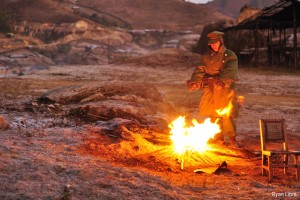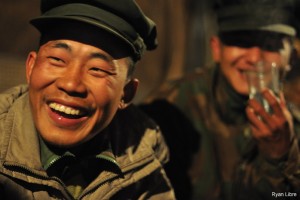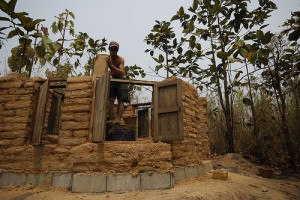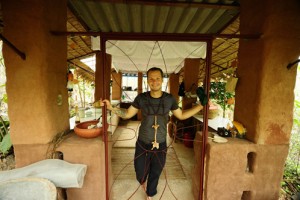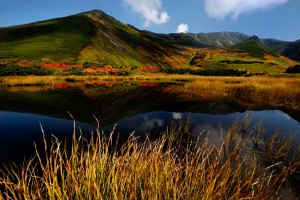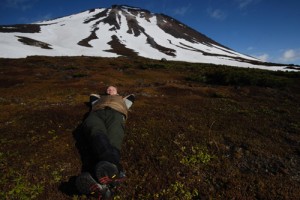A MAN IN A heavy military coat stands close to a leaping fire. He’s alone. His hands are out, welcoming the flames as he studies them. There’s nothing around but wasteland and an empty chair, a reminder that at any time you may sit. But the man chooses to stand. It brings him closer to the fire.
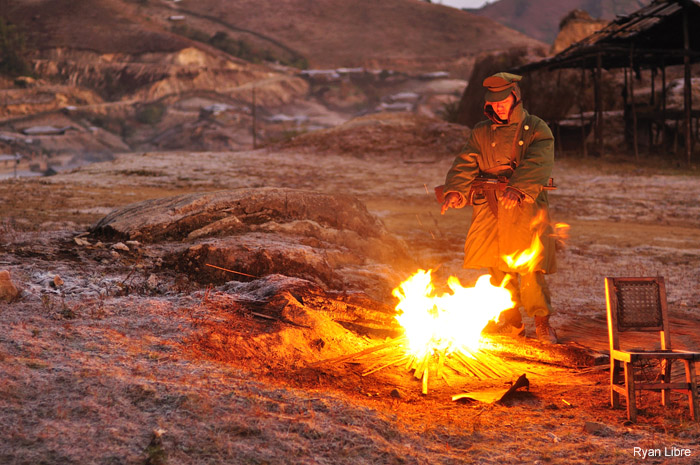

"Less Places You Go, the More You See": Documentary Photographer Ryan Libre
Like the man in the picture, Ryan Libre chooses to stand. He went AWOL from the US military and later earned a degree in Peace Studies. He spent two years living homeless and now lives in an adobe hut he built with his bare hands. Yes, there are a lot of poetic things to say about Ryan–take his last name, for example–but it’s better to let him speak for himself.
Between winning awards, putting on exhibitions, traveling, and finishing up your adobe hut, you’ve been really busy. Just what have you been up to in the last few weeks?
Ryan Libre: I’ve been all over the place. I just spent three weeks in the Kachin state, at the Kachin Independence Army (KIA) headquarters on the front lines. I wasn’t planning on going, but fighting broke out again, starting about 2 months ago. There was a ceasefire for quite a while, but after it started up I went as fast as I could and spent about three weeks with them. After I finished up doing a lot of photos and videos and writing there, I headed to Japan and now I’m in Tokyo taking photos of the Kachin refugees, there’s about 500 of them here.
Unfortunately, I’m pretty unfamiliar with the Kachin Independence movement. What case are they making for sovereignty?
Legally speaking, they have a signed agreement, the Panglong Agreement, that’s signed by Nobel Peace Prize winner Aung San Suu Kyi’s father, who was the head of the Burmese government at the time. They were an independent country until 1947, when they agreed to join the union, but it was under the terms of complete and total autonomy and the ability to secede if they felt like it wasn’t working for them. It was supposed to be like what the EU is today. They’d work together for roads, works, money, but the Burmese government took all their resources and gave them nothing back, forced the schools to teach Burmese and suppressed their religion as well.
What was the general feeling like during your last visit to Kachin?
Well, I went to the front lines, and every day there was fighting but it was changing locations every day. I tried to go where I thought there would be something, but it kept happening that it was somewhere else. But I talked to a lot of people who were fighting. The whole feeling in the city, though, has really changed. Everyone’s very alert and alive, and serious about their work. I wrote an article about “The Honeymoon of War,” when it felt like a honeymoon phase because the war had just begun and everyone had been preparing for it. But the realities of a long term war…there’s already 20,000 refugees, after a while, these things get very serious and difficult to deal with. But when it just starts, it felt like everyone was very excited and even celebratory.
The Kachin’s struggle for independence definitely gets little to no coverage in the US media, but what about more locally, over in Asia?
It’s still very low on the radar here. There’s almost no media in the world covering this, not even the Burmese media. They’re trying to hide it. China, no. Thailand, no.
How do the Kachin respond to the work? I’d imagine they’re very happily receptive.
Yeah, extremely. Not only my work, but one of the things about Kachin culture is that they’re very welcoming of guests in general. They’ve got a very developed sense of hospitality. That goes across the board no matter what you’re visiting them for. On top of that, they support my work as well.
While you’ve been in Kachin, have you ever find yourself in any very dangerous situations?.
Well, you know, I’m always going there illegally. In the end it’s kind of relative, but it’s not what I guess most middle-aged middle class Americans would call safe. At the end of the day it’s not THAT dangerous, but there are people that get arrested. There are lots of Chinese and Burmese army and spies making sure people aren’t crossing the border.
But I don’t know, I’ve been across the border 20 or 30 times now illegally and I haven’t run into any trouble yet. The first time I made it into the country by crossing a river in the middle of the night.
Do the Kachin speak English?
I’m learning their language, Jinghpaw, and can have quite basic conversations. But generally we’re speaking English with a translator. I’ve really understood English in a different way after working with them, because if they don’t know English, they really have no access to good news. Their neighbors, the Burmese, Chinese, and Thai, none of them are exactly known for freedom of information.
Since the Kachin have no voice in their own media, they take English language education very seriously. It makes a huge difference if they can communicate in English and read the news, there are so may more resources available and outlets to be heard. Even the KIO set up a 2 year English language junior college to teach among the youth an intensive English program.
They’re extremely well organized and forward thinking. It’s not what most people think of as a rebel army, I think. The region is extremely impoverished. But by and large if you compare the Kachin who are living outside under the Burmese government to those in the Kachin state, those under the KIO have access to better hospitals and schools and generally better infrastructure. It’s all relative, in a sense, it’s not gonna look like Tokyo, but considering the resources that they have and the things the neighboring countries have done, they’re being extremely progressive.
Switching gears here, I’d like to go much further back. I know you decided to go AWOL from your position in the Army National Guard, but how’d you find yourself in Asia?
I had a friend that went there and said it was cool, blah blah, it was very basic, but when I went there, it didn’t feel like somewhere that was just interesting or entertaining, it felt like home. In many ways more than the US felt home to me. one of the first things I did was spending not more than one week traveling, and then I started wwoofing. I ended up on this really cool farm on the countryside, and just the whole worldview of the people who lived there seemed very in tune with my worldview, I guess. I feel like not too many people in the states shared my worldviews.
Did you feel like you were fleeing something or just needed a new start?
I wouldn’t call it fleeing, I had worked out the situation with the AWOL about a month after I left, but that was not a legal issue. I was looking for something new. I didn’t really expect it to turn out what it was. I was planning on spending about 5-6 months traveling around southeast Asia. I didn’t have a plan, but that was the general idea. And I just kind of stayed.
What created a turning point for you in needing to do this?
It was actually Critical Mass. I’d spent two months organizing the first Critical Mass in my hometown, and it just so happened that my training got changed to start on the same day at the same hour of this Critical Mass that I’d been planning for about two months. Building up to that point I felt like there were a lot of signals coming at me that were saying ‘You don’t really belong here’, and I felt like the time being changed was kind of like the universe throwing a curveball at me, forcing me into a decision, so in the end I did the bike ride and sent the letter.
What was it like explaining to everyone that you wouldn’t be back in a while?
I don’t think anyone was really surprised. At the time that I left, I was homeless in the states, in Chico, California. Most of the year I was living just with a sleeping bag, not even a tent. Sometimes in the rainy season I’d set up in a park or a friend’s back yard.
It was mostly a choice, though, it wasn’t something that was forced upon me at all. I guess in one way, while I had an apartment, I was paying rent, but it felt like a weight that I didn’t really need. So then I had a massive tent in the back of my friend’s house and I lived there for a while paying $20 dollars a month for rent. But even then those things began feeling kind of heavy for me. I was studying Buddhism quite intensely, and felt like the more and more things I “had” the more I felt weighed down. And it became kind of a progression into a normal-sized backpack full of things.
My home now is a handmade adobe hut outside of Chiang Mai, Thailand.
Yes, tell me about it. How long has it been in the works for?
I bought the land about 7 or 8 years ago, and it laid dormant until I started working on it about 5 or 6 years ago. Tim Patterson was actually there building with me from the beginning. He stayed about 1 or 2 months there with me helping me build the first hut. I’ve been working on it for about 5 years and it’s at a point right now where it’s quite comfortable. I have like 5 or 6 different buildings now, a hut just for sleeping, an office, a kitchen, a tool shed, a shower, a bathroom, and a mushroom house, and they’re all separate buildings in the forest. It’s about a football field sized piece of land.
I bike into town sometimes and there’s a local truck that goes in once in the morning at six, but I don’t have a car or anything.
What drew you to adobe and what have been some challenges?
It was the first type of WWOOFing that I’d done. The woman at the farm had gone to a temple and built a hut for one of the monks, and I helped her with that. I really just fell in love with it from the beginning. Part of the reason I was homeless was the feeling of it being heavy. But these buildings you can build yourselves for free with basically no environmental destruction. It completely changed my thinking about ‘what is a home?’; it has no environmental damage, no mortgage, no building codes. It was a total epiphany: after being homeless for 2 years, I wanted to build a house.
I should also say that in terms of how long it took to build, the first building took 3 months. I say it ‘took 5 years’, but I was gone most of the time. So I’ve actually only spent about 9 months total actually building my house.
What about during the rainy season? Does it require any additional upkeep?
No, it’s pretty straightforward. If you’re in a situation that gets a lot of wind, you might want to build a bigger, longer roof, basic things like that. Especially for me, most of the rain falls straight down, hitting a tree before it hits the wall. It’s very simple.
On the outside of the bricks, there’s a layer of inch-thick mortar, so in a worst-case scenario, it would take about a year or two to wear away the mortar and then you’d start to see the bricks, and then you can just put the mortar back on in a couple hours. It’s very low maintenance and very intuitive I think as well. I didn’t have to consult any outside resources, but my neighbors do happen to be one of the best and most established builders in southeast Asia, but when Tim and I were there starting, they were nowhere around.
Does the hut have running water or electricity?
I just have rainwater and a small solar panel. My solar system only cost about $500, and it’s a bit on the slim side but at the same time, what most of us, most of the folks in the Matador community do is have a laptop that uses a quarter of the energy that a light bulb did while we were growing up, and we use it for everything. It’s a very little amount of energy.
How did you get involved taking pictures/becoming photojournalist?
Well my mother’s a painter, and I had done painting through junior high and high school, and it was something that didn’t really come intuitively to me. When I was just starting university, I used my first college grant to buy a camera and it was really intuitive to me, and I immediately started using it to show my worldview and document some stories that I was interested in, mainly homelessness and animal rights.
Had you done any published work before going to Asia?
No, but I had done some exhibitions in university (Chico State), so it was something that I was quite heavily involved in.
You’ve published some work here at Matador before and have been a great connection for a long time. How did you first get introduced?
From Tim Patterson, we met in Japan. When I moved to Hokkaido he was the first person I met, and we spent a lot of time together biking and hiking around the mountains. And then he was going to Cambodia, and he wanted to write some stories about the Koh Kong province by the ocean and on the Thai border, and he invited me to come with him to take some photos. We’ve been very close friends ever since. He came to Kachin with me the first time I ever went. Unfortunately, I haven’t seen him in about 2 years.
Tell me a little about the arc of your photography career.
In the very beginning, most of my projects were actually about homeless people, and then animal rights. I was very involved in those two things at the time that I started becoming a photographer. It was after Japan that I decided I wanted to do photography full-time. I guess you could say my first major break was in landscape photography in Hokkaido. So I kind of started documentary-style and then went to nature, and after meeting Tim and going to Cambodia I went back to doing documentary.
What are some other projects of things that you want to tackle?
I want to move towards a social, documentary-in-nature style but maybe be more artistic in presentation. One project that I plan to start quite soon is called Black is Beautiful, and it’s portraits in the studio of very dark-skinned Thai men and women. There’s a huge discrimination right now against people with dark skin in Thailand, and all of Asia really. So I kind of want to tackle that issue but not through the traditional sense. I want to actually bring people into the studio and try to do something more conceptual, but at the same time try to hit at the heart of this serious social issue. I’m really looking forward to that.
I’m kind of moving more and more towards local projects that are, I guess, personal to me. If there’s a message that I could give to the people that want to become photographers, it’s that in the end, the less places you go, the more you see. There are so many photographers now and whether they’re amateurs or professional, they’re running around too much. They’re trying to document too many things in too may places, and quality kind of comes from picking something small and doing it well. So I’d like to travel a lot less and take photos of things very close to me.
I’ve read that you spend very little time post processing. Why is that?
To me there’s a very important element of my feeling and my judgment at the time that I’m standing in front of someone or someplace or something. It’s like I can choose much better how I want to represent the situation, and also my feeling at that moment, I think, is kind of solidified in the photo. So I’m making a lot of adjustments in the camera at the moment, with the white balance or the contrast, but I’m really trying to express what I feel and what I experience at that moment. It’s something very different to me when you’re looking at that image later. That whole moment is gone.
Do you ever feel at odds between the naturalistic goals you have for your adobe home and your livelihood and art that are based in digital technology? They’re two very different ends.
I don’t feel much at odds. My motto in some ways is “back to the future.” I’m not nostalgic at all for darkroom prints, and I really like to seriously evaluate new technologies in terms of their environmental impacts. And when those things do work, it makes great progress. And for me I love to work with digital–it allows me to work without chemicals, it’s much cheaper, and I can work more freely and quickly.
I have very little interest, though, in the camera itself. I never talk about my camera. You have to ask, “Is it the gear or the photography that I’m interested in?”
Do you enjoy traveling anywhere outside of Asia?
I’ve been pretty much fixed here. Like I said, the less places you go, the more you see. I haven’t even been to neighboring countries like Vietnam. I like finding little niches that I like and going back to them year after year, making the story deeper and making a sort of timeline. I’m not really interested in traveling personally or as a photographer outside of these areas where I have some experience. Even 20 or 30 years from now I can go to these places and there’s still more to uncover. I actually turned down a thing with Tim Patterson in South America for 6 months. At the end, I was like, “What is 6 months in South America?” I wouldn’t know anything.
And when’s the last time you were in the states?
About 4 years ago.
Do you have any words of advice for those looking to take their photography or art to the next level?
Take something that either you’re really interested in or curious about, one topic, and really work it to death. Really explore it in all its possibilities and faces. I think you’re gonna come up with some much better photographs and learn a lot about the topic in a way that you don’t really learn by just kind of thinking “oh this is a nice sunset, and there’s a butterfly.” By really focusing, really exploring one thing, you can learn so much about the topic, photography, and yourself.
